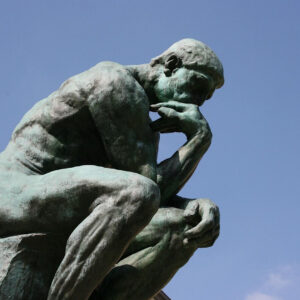A friend of mine recently returned from a yoga class dissatisfied. When I asked her why she didn’t care for the class, she replied that the mood in the room was “too happy.”
Well, what’s wrong with being happy? After all, if an optional activity like a yoga class, is not bringing happiness, then why the heck should one participate? Life is tough enough, we all need a break, and yoga is supposed to bring peace. Was the problem really with the class or is my friend just an oddball (which might well explain our friendship)? Since all the yogic literature, and teachers such as myself, clearly state that yoga does lead to greater happiness, how then does the process work?
Before we examine the relationship of yoga practice to happiness, let us explore a stunning vision experienced by the great Indian sage, Ramakrishna, who lived from 1836 until 1886. This is not only relevant to our discussion regarding happiness, but it is particularly pertinent as I have studied under two gurus in Ramakrishna’s lineage, Shree Maa and Swami Satyananda Saraswati.
Ramakrishna was sitting on a beach near the Ganges River in India. From out of the water he saw a radiant young maiden arise. She walked out of the river, laid on the sand, and gave birth to a beautiful baby. Next, she tenderly nursed the child, who contentedly suckled her breasts. Then, she turned into a fierce creature who devoured the child. Finally, she walked back into the River.
What a vision! How powerful and, perhaps, more than a little disturbing. Yet what an accurate depiction of the cycle of Mother Nature. For it is one divine energy, say the yogis, which gives birth to all life, nurtures us, and then ends our days. The entire cycle of life, which includes death, is sacred. In Nature’s wisdom, She has decreed creation, preservation, and destruction as the intertwined threads of her tapestry.
Even putting aside Ramakrishna’s vision, as sensitive people we naturally delight at the thought of a healthy young woman giving birth and nourishing her baby. Yet we tend to recoil from the idea that the same energy which brings birth is also the cause death. It is simple for us to see the beauty and love in Nature’s gentle expression, but so much harder to appreciate Her ferocious and violent forms. We somehow wish we could have the lamb without the lion.
We are confronted daily with the reality that life requires death. Every meal that we eat, every breath that we take, confirms this truth. Even vegetarian yogis must acknowledge that the carrot on our plate has been killed to feed us. For one life to live, another life must be sacrificed. Our knee-jerk reaction to this reality is often to try and ignore it, or at least avoid the thought that whoever is eating today will, without exception, be eaten tomorrow.
The yoga path recommends looking this reality right in the eye, because by doing so we are able to penetrate beyond the fear of death. We come into contact with a divine consciousness at the root of the cycle of life and death, and we begin to realize that all aspects of life are holy, part of a whole. Not only that, we recognize how we are integral parts of this whole. This direct confrontation with reality goes a long way towards easing our feelings of isolation and loneliness. We realize we are not apart from the whole, we are intimately a part of the whole.
In yoga class we have the wonderful opportunity to learn how to enjoy our abilities and respect our limitations. In order to learn these skills, however, we must actually discover our current responses. Most people have the tendency to avoid fully acknowledging their strengths and sincerely admitting their weaknesses. This avoidance is not an expression of balanced self-esteem; it the result of avoiding both our potential to be great and our fear of being hurt.
This evasion of the full range of experience is actually a dread of losing our mind-created sense of security. Called abhinivesha in the yogic literature, it is an instinctual clinging to what we hope will make us feel secure. If this clinging worked and actually provided security, everything would be alright. But since life is always changing, nothing stays the same from day to day, and death is inevitable, clinging as a strategy for security just isn’t effective.
To leap outside of this impotent mental box, we must be willing to experience the vastness of our consciousness. We must risk allowing our limited sense of self-identity – the daily, ordinary, mundane personality – to expand into its potential. We must awaken to the divine nature of our birth, our life, and our death. Like Clark Kent entering the phone booth, we need remove our superficial mental clothing to reveal the superhero.
It’s certainly not necessary to attend to these profound issues every time we roll out our yoga mats. Sometimes we just need to stretch and work out the hamstrings. From the yogic perspective, however, stretching is a perfect opportunity to come into contact with this philosophy we are discussing. For your body is entirely a construct of Mother Nature and, if you pay attention, it will provide you with all the opportunities possibly needed to address abilities and limitations.
The beauty of a good yoga class is that it is a consciously devised milieu in which the student has the opportunity to watch these reactions, and then learn to smile gently at them. If you pause and think about it, no one should be overly concerned if they can’t get their nose to their toes, right? But isn’t it amazing how something so trivial can feel significant and actually bug us?
The beauty of learning about our responses is that we become aware of how we define and react to perceived failure. Then, in real life, when confronted with situations which trigger these same feelings, we are already familiar with the dynamic. With this greater awareness, we gain an increased ability to responded with patience, acceptance, and a gentle sense of humor.
A good yoga teacher is one who has spent time facing his or her own limitations and unhappiness, and has practiced enough yoga and meditation to realize how to get past them. The way past them is through them. The way to peace and happiness is through the turmoil of fear and sadness.
Ordinary people, just like you and I, have the awesome opportunity to overcome many of our fears and anxieties, and live in a more peaceful and vibrant manner. It takes effort, it takes introspection, it takes a willingness to forgive and not take oneself very seriously. Considering, however, that we are talking about healing deep-rooted conditioned reactions, coming into harmony with Mother Nature, confronting death, realizing the sacredness of all life, and finding some lasting happiness, I think it’s reasonable to say, “It’s a little bit of work for a whole lot of benefit.”
Yoga is not a path of masochism, and there is no sense seeking for unpleasant experiences. Life provides plenty of stress without any lobbying. Yoga is a path, though, of learning how to peacefully deal with trying times and difficult people. If yoga practice is to be successful at this, it requires we avoid sugar-coating our feelings and sugar-coated ideas about the world. If we want some real peace and deep contentment, we will need to dive deeply into the full experience of life. Then we can learn about the yoga of happiness – a balanced inner state where we are cheerful enough to enjoy ourselves, while at the same time facing up to our limitations and opportunities for growth.




